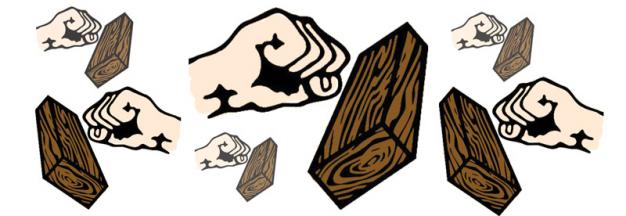By Linda Browne
April is here, the month of pranks, hoaxes (which seem to get more elaborate every year) and all kinds of fun foolery. If you’re a superstitious type, you might be knocking on wood a bit more heartily this time of year to protect yourself from becoming prey to pranksters and to keep your good fortune flowing. Or maybe hitting your knuckles against the nearest table, chair or whatever wooden structure you can get your hands on (literally) is just something you do in your day-to-day to avoid bad luck.
Ever wonder where this strange custom comes from? Charles Panati (writer, science editor and former physicist) gives the lowdown in his book, Extraordinary Origins of Everyday Things.
Kids who play tree tag, in which players touch a tree to ensure their safety, Panati explains, “are unwittingly enacting a 4,000-year-old custom” that started with the Indigenous peoples of North America.
“In the modern game of tag, the base of any tree serves as a safe haven. Historically, though, the tree to touch was an oak, venerated for its strength, stately height and numinous powers. Furthermore, when a person today ventures a hopeful prediction and superstitiously knocks wood, that wood ought only to be, traditionally, oak,” he writes.
Cults surrounding the oak tree, Panati continues, “are ancient,” starting with the Indigenous peoples around 2000 BC and later, the early Greeks. “Both cultures, observing that the oak was struck frequently by lightning, assumed it was the dwelling place of the sky god” (the former) and “the god of lightning” (the latter), he writes. The former also “held that boasting of a future personal accomplishment, battle victory or windfall harvest was bad luck, a virtual guarantee that the event would never occur. A boast, deliberate or inadvertent, could be neutralized from sinister retribution by knocking on the base of an oak tree. In effect, the person was contacting the sky god, seeking forgiveness,” Panati adds.
Once we roll into Europe in the Middle Ages, Christian scholars proposed another theory to explain the origins of this ritual, which they claimed “originated in the first century AD and stemmed from the fact that Christ was crucified on a wooden cross,” Panati writes. “To knock wood hopefully was supposedly synonymous with a prayer of supplication, such as: ‘Lord, let my wish come true.’ But modern scholars claim that there is no more truth to that belief than to the onetime boast that every Christian cathedral on the European continent possessed a piece of wood from the true cross. Thus, the Catholic veneration of wooden crucifix relics did not originate the custom of regarding wood with awe; rather, it mimicked, modified and reinforced a much older, pagan view.”
Other cultures, Panati adds, held other trees in high regard. For the Egyptians, for example, it was the sycamore; for ancient Germanic tribes, the ash. The Dutch, he says, “adhered to the knock-wood superstition, but for them the kind of wood was unimportant; what mattered was that the wood be unvarnished, unpainted, uncarved, in every way unadorned.” Tree cults, he says, were common throughout history “and they are the point of origin of many modern superstitious practices, such as kissing beneath mistletoe.”
The practice of knocking on wood as we know it today, Panati explains, comes from the early Greeks, which was passed on to the Romans and eventually, the Britons. “In time, when oak was not conveniently at hand, a rap on any type of wood sufficed. And in today’s high-tech world of plastics and laminates, the knock-wood superstition persists, even though real wood, of any kind, is not always in arm’s reach.”
In his book Black Cats & Four-Leaf Clovers: The Origins of Old Wives’ Tales and Superstitions in Our Everyday Lives, writer and editor Harry Oliver offers up another explanation. He writes that other sources “argue that the custom of knocking on wood is not ancient at all and is simply derived from a 19th-century children’s game called tig-touch-wood, in which children would be ‘safe’ during a game of tag when they were touching wood.” (However, as Panati posits, this game was inspired by the early practice of rapping an oak tree to summon the protection of the gods.)
While in the past, one had to rap their knuckles against an actual tree trunk in an effort to not tempt fate, these days “simply saying ‘knock on wood’ is considered enough,” Oliver says (good news for our modern, time-stressed society).












